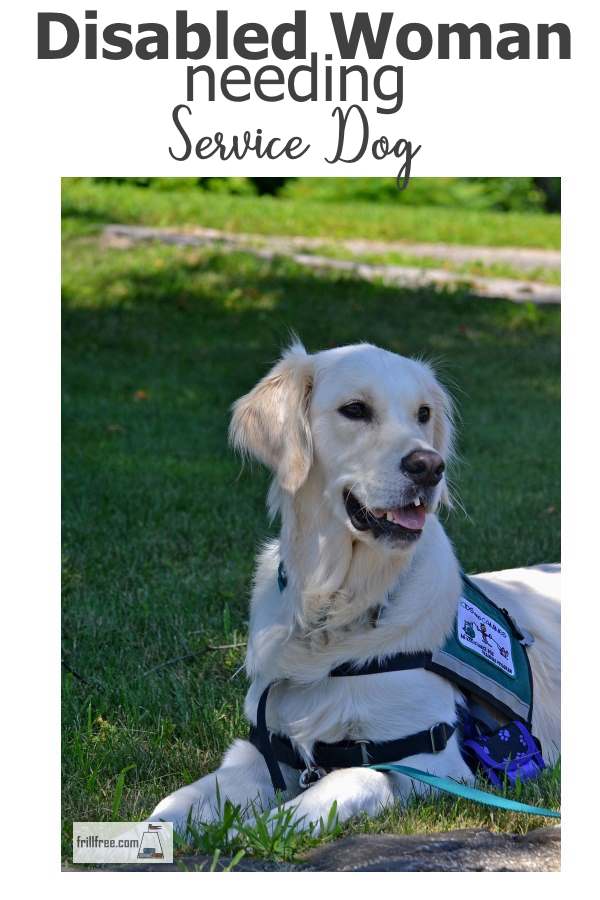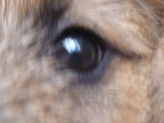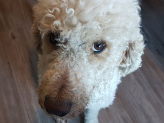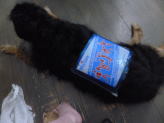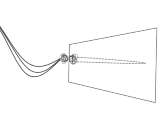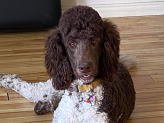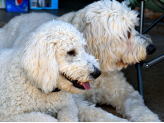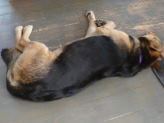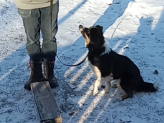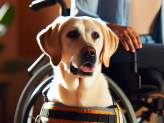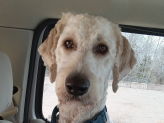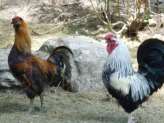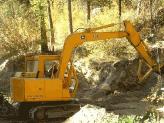- Homesteading
- MS Service Dog DIY
Disabled Woman Needs an MS Service Dog
Balance Assistant, Dropped Item Retrieval, and More
With a little help there's no reason why you can't train your own service dog. The advantages are many - not least of which is the cost.
I need some specific traits in my service dog, so I specifically looked for a puppy who would have some stature as an adult.
Originally, my choice of breeds is not one that others would find a good selection, but Mastiff x Rottweiler x Bouvier des Flandres is what I went with. Each of these breeds on their own is trainable, and used for protection, support and farm work. So my thinking is that this type of mix will be reliable and calm (eventually).
So it begins. I've found some good resources, including one forum and website which teaches clicker or marker training, and a Facebook group and affiliated website solely dedicated to training a personal service dog. There are many other options out there, choose the ones that make the most sense and are easy to navigate.
Those of us with MS know that having a companion who will also give us assistance in day to day living is golden.
Many of us have family members to help us on bad days, but sometimes they too need to get away for shopping, other errands, and just for a bit of time for themselves.
This disease can change day to day, without warning. Diet is a huge help, but if we get a virus, that is out the window. Supplements can only go so far to prevent a flare.
That leaves us with a quandary; how do we keep active and safe, without someone there? Enter; Service dogs who are specifically trained to help those with Multiple Sclerosis.
For my second attempt, I went with a goldendoodle.
Meet Ash, my latest service dog in training (or SDIT). Until he is fully trained, he's allowed to go anywhere, even non-pet friendly places such as doctors offices or into government offices that normally don't allow any animals.
This is to help with his socialization and to give him much needed exposure to different things that he normally wouldn't see, such as noises of traffic, more people, odd things like automatic doors and elevators, and confined spaces. The biggest problem so far has been a bit of submission piddling, and people just can't resist talking to him and wanting to pet him!
In time, he will find it old hat, and it won't cause him to have this issue. For a dog that was so easy to potty train, and never messed inside, it surprised me when it happened in the library and at the vets.
He's fully hypoallergenic, I have no allergic reaction to his fur, even when I put my face right in it. He sheds not at all. Which is a crapshoot with any doodle, even those with high percentage of poodle.
I self train, so he's completely adapted to my needs, which are balance assistant, and to pick up dropped items and return them to my hand. He loves to retrieve, and then will bring them back to me - not releasing them so much though! All things with time, he's getting much better with 'drop'.
When I ask him 'help' he will align himself to my left hand side, and I can grab his collar or vest to give me some balance help, not weight bearing, as he is too young, and also too small.
His full adult weight is around 60lbs, so I can't allow him to counter balance or support me.
Training my own MS service dog is something I have wanted to do for many years, it didn't work out with the previous puppy I had, but with Ash, I'm confident that he will give me a new lease on life and help me immensely.
For the future, as my gait is so impeded, I will need to train him to walk beside a scooter or trike, and I will finally be able to go on 'walks' with him.
Training Your Own Service Dog
Depending on what kind of assistance you need, your ideal service dog can be almost any size. For a diabetic alert dog, even a small dog will be perfectly capable of helping you avoid high blood sugar, and even be able to bring your medications.
Larger breeds are most used for bracing and balance support, as well as retrieving, guiding and protection.
Some breeders of purebred dogs are concentrating their efforts on producing puppies with the skills necessary to become a good service dog, but there are plenty of mixed breeds and even rescue dogs that have exactly the right traits.
A puppy in the case of a rescue dog might not develop into the support you need, but a younger adult dog might be exactly right.
Look for a dog or puppy that is calm, that's one of the most important traits, and one of the hardest skills for them to learn.
Keep in mind that most service dogs need two years to mature from puppy age, and it takes at least that long to train all the skills they'll need. After that, they could live for ten or more years, but some of that will be in retirement.
My journey began with Sable as a potential assistance dog but unfortunately, she washed at about seven months due to hip dysplasia.
I learned so much from her, even if she didn't work out to be a service dog. Now I use the knowledge and skills to train Ash.
There are many ways to train dogs, but the method I've chosen is to use positive reinforcement rather than forceful methods such as prong collars, choke chains or e-collars.
This is a new world for me. I did a lot of playing with Sable, giving her lots of exercise with a flirt pole, and teaching her to walk politely.
Play is one way to socialize your puppy, as well as to bond with them. Additionally, it wears them out so they sleep well. Ash has learned a lot about give and take, retrieving to hand, and recall, just using the games we play and toys as bait and reward.
